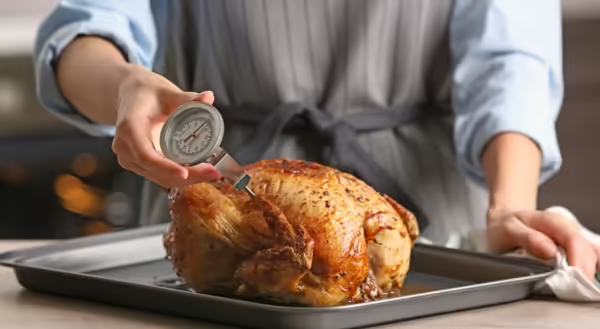
Well, as you think about them, here are some quick ones to put on the list if you do not have any. Refrigerator thermometers, freezer thermometers, and cooking thermometers. These thermometers are very important to have and to use if you would like to ensure food safety at home or in your restaurant.
Most microorganisms that cause foodborne illnesses can grow within a temperature range of 40 F to 140 F. This range is also referred to as the temperature danger zone. When perishable food items such as meats, poultry, fish, dairy, salads, are exposed to the temperature danger zone for more than two hours, harmful microorganisms can multiply rapidly to levels that can make us sick. Controlling and monitoring the temperature of these foods during storage and cooking is one of the ways we can reduce potential foodborne illnesses. Thermometers will help to measure the actual temperature of the air around the food and the food itself.
Refrigerator controls should be set such that the thermometer reads 40 F or below while freezer controls should be set such that the thermometer reads 0 F or below. These cold temperatures will reduce the speed at which harmful microorganisms multiply but may not kill them.
Cooking on the other hand should be done such that the food reaches the minimum internal temperature that is recommended to ensure harmful microorganisms are killed. This chart shows the minimum internal temperature for different foods. In addition to safety, checking the temperature of food using a thermometer while cooking ensures you do not overcook the food and that you save energy. The color of foods like meat can be influenced by several factors, and so it is not a good indicator for when food is done cooking and safe to eat. There are many kinds of cooking thermometers to choose from. Some are digital thermometers and others are dial thermometers. Whatever your choice is, it is important to check that the thermometer measures temperature accurately using the ice water or boiling water calibration methods, and that you know how to use it properly.
When using a cooking thermometer, place it in different parts of the food not forgetting the thick ones, and each time make sure the sensor is inside the food, and that the thermometer is not touching fat, bone, or the container in which the food is placed. If any of the temperature readings is below the minimum internal temperature, you should continue cooking and check the temperature again. After cooking wash the thermometer with soap and water or follow the manufacturer’s cleaning instructions before storing it.
Use a thermometer when you travel with hot food or cold food for longer than 1 hour and remember to regularly check the temperature of hot food or cold food displayed or served at gatherings. Hot foods should be maintained at 140 F or higher and cold foods at 40 F or lower.
Bonus uses: If you happen to experience power outages, you do not have to discard all food in your refrigerator or freezer. Check their temperature first. You may reduce food waste. Thermometers can be used for other temperature sensitive work in the kitchen like making homemade yogurt.
Gift yourself or someone you love at least one of these thermometers this holiday season and remember to use it regularly even if your favorite chef or recipe does not ask you to!
Resources
A short video about calibrating a thermometer using the ice water method.
A short video about calibrating a thermometer using the boiling water method.
Short video showing how to use a food thermometer with different foods.